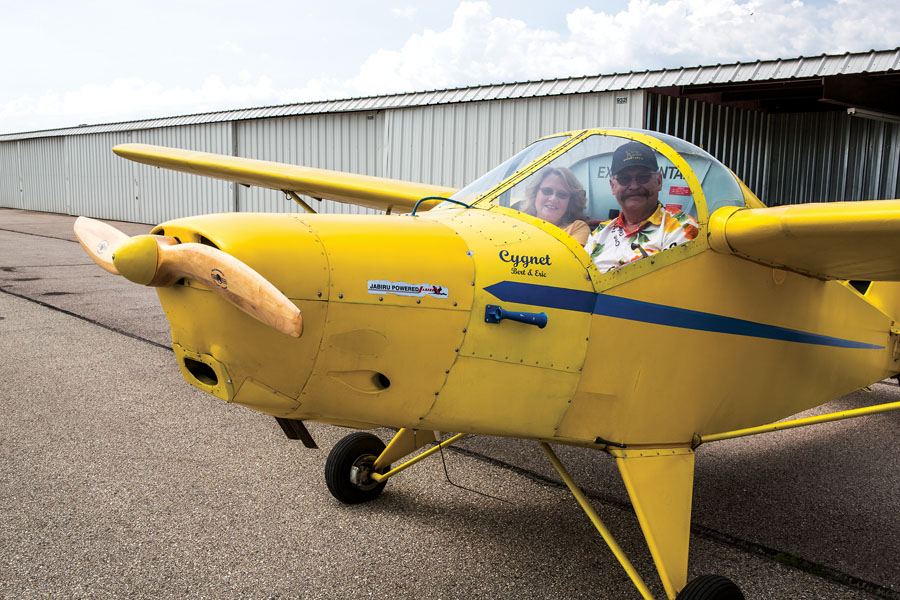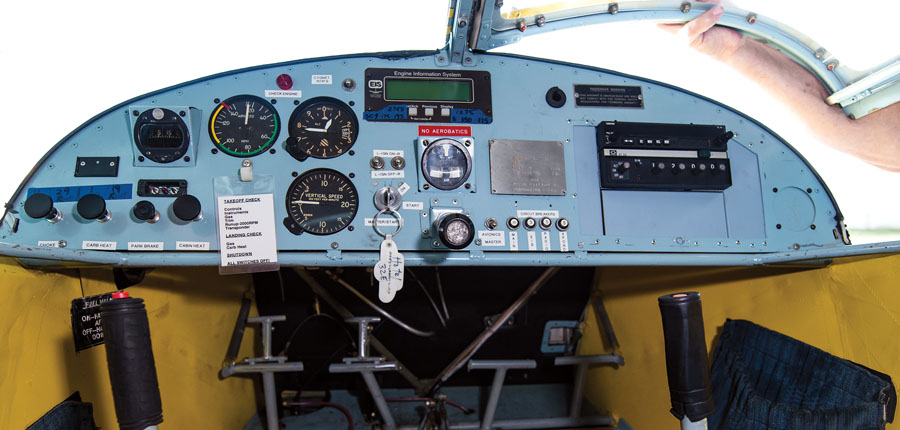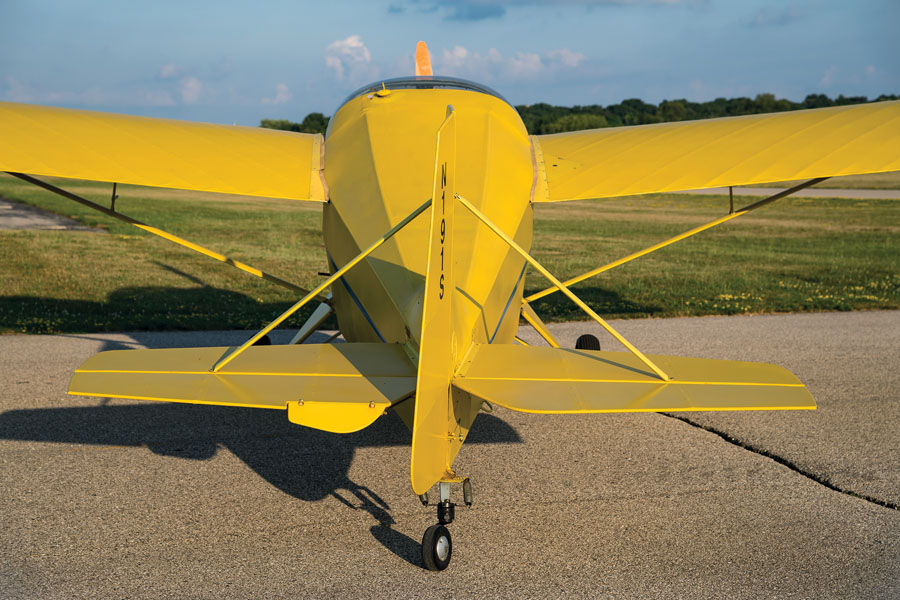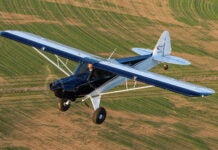Anyone who has seen the Cygnet SF-2A will remember the two-seat, side-by-side taildragger because it looks like no other. Contrary to the high- or low-wing choices favored by designers of Amateur-Built and certified aircraft, the Cygnet extends its wings from the shoulder like outstretched arms. Even more unusual, the wingtips are 14 inches ahead of and 11 inches above the wing root. And in the right light, looking across the 13-foot span of each panel, it is clear that the fabric is attached to diagonal members instead of fore-and-aft ribs.

Robin and Patrick Taylor. The prototype Cygnet has been a member of the Taylor family since 1981, when Rex Taylor, Patrick’s father, acquired it and the rights to its design.
Each of these features serves a specific purpose. Designed by Albert “Bert” Sisler, the Cygnet first flew in 1973 and earned an Outstanding Design Contribution award at its EAA Oshkosh debut that year. The shoulder-mounted wings provide the pilot with a clear field of view above and below the wing without cockpit contortions and lifting or lowering a wing, said Patrick Taylor. He should know. He earned his Private Pilot certificate in the prototype in 1980, and he flies it today from its home at Wisconsin’s Burlington Municipal Airport (BUU).
The wings’ five-degree forward sweep improves the pilot’s field of view, but its primary purpose is to keep the center of lift ahead of the wing roots, which creates a center-of-gravity envelope that contributes to the airplane’s docile handling. The seat backs in the 39-inch-wide cockpit align with the wing roots, and immediately behind them is the 13-gallon fuel tank, and below that is the marsupial baggage pouch that holds 70-pounds. Ahead of the day-VFR panel is a two-gallon header tank and the engine, either a 60-hp 1835-cc VW conversion or an 85-hp Jabiru 2200 (more on that later).

Thanks to forward-swept, shoulder-mounted wings, the Cygnet’s pilot and passenger have an excellent field of view from the cockpit.
Building the wood wing follows the conventional layout with 11 plywood main ribs that form each panel’s NACA 3413 airfoil. But these panels are covered by a geodetic latticework of spruce strips that carry the drag, anti-drag, torsion loads, which is why the wing is supported by a single lift strut attached to the main spar. It is also lighter, less expensive, and easier than skinning the wings in plywood. The fuselage is a traditional truss of welded 4130 steel, as is the tail. The wide landing gear is similar to a Piper Cub, with internal bungee cords.
Sisler, a mechanical engineer, soloed in 1941 and retired from Northwest Airlines as a Boeing 747 captain. He explained his design philosophy and goals in “SF-2 Design Presentation” that appeared in the November 1973 issue of EAA Sport Aviation. “This airplane is designed to be a practical, safe, easy, and fun-to-fly machine for the occasional pilot. One that is comfortable, and companionable. The airplane is not built for aerobatics, but is designed to ‘utility category numbers,’ so a few dips here and there are not out of order.” Construction requires no special tools, and “the overall length and tail span are deliberately picked to fit a garage stall.”
What Sisler did not explain is why he named the airplane after a young swan.
Family Affair
The prototype Cygnet has been a member of the Taylor family since 1981, when Rex Taylor, the founder of HAPI Engines, acquired it and its design rights because it was a good fit for the company’s VW conversions, said his son, Patrick. When he acquired the design rights, Taylor formed Viking Aircraft to sells plans and support builders for the Cygnet and another design powered by a HAPI Engine, the single-seat composite Dragonfly. Now owned and operated by Patrick and his wife Robin, Viking has sold Cygnet plans ($200 for 20 sheets, 24×18 inches, that include a full-size rib drawing and a serial number and agreement to build one airplane from them) without interruption.
When HAPI Engines acquired the prototype Cygnet, Patrick was learning to fly in a Cessna 150. He completed his training in the Cygnet, earning his private ticket in 1981. As is the nature of time and business, the airplane moved on to another owner in the 1990s.

Below the fuel tank and behind the sling seat is the marsupial baggage compartment rated for 70 pounds.
About 20 years ago, the new owner contacted Sisler and his son Eric to see if they might be interested in reacquiring the airplane, minus its VW engine. “Of course they did,” said Robin. “They went through it and made it sound, and put a Jabiru engine on it.” Shortly after his 91st birthday, Bert decided it was time to retire from flying. That was “about a year and a half ago, and Bert and Eric asked if we wanted to purchase her back.” Patrick, who holds an A&P, as well as a private pilot certificate, hadn’t flown in 20 years, Robin said, “so we had to think about this.” But they didn’t have to think for long. Eric Sisler delivered the airplane in August 2015 and checked out Patrick’s flight instructor in the Cygnet. Patrick returned to the sky in the airplane in which he learned to fly and made his solo flight in it on November 10, 2015.
The new engine makes a good airplane even better, said Patrick. “With the 60-hp VW the Cygnet cruises at about 90 mph on 3.5 gph. With the 85-hp Jabiru, it cruises at 100 mph on 4.5 gph.” The plans do not now include the Jabiru mount, but this addition topped Viking’s to-do list when the Wisconsin winter brought an end to the 2016 flying season. With the airplane out of service, Viking planned to document Sisler’s Jabiru installation.
At best guess, said Robin, Viking Aircraft has sold more than 500 sets of plans and, worldwide, more than a hundred of them are flying. One of the newest members of the fleet belongs to Jerry Folkerts of Bowling Green, Missouri.

Designed for a 60-hp VW engine, the prototype is currently flying with an 85-hp Jabiru. The result was an increase in cruise speed from 90 mph on 3.5 gph to 100 mph on 4.5 gph.
Construction Time
Viking Aircraft suggests that builders will invest approximately 1700 hours in Cygnet construction. That works out to 18 months for builders who dedicate themselves to 25 hours of shop work every week. Alvin Sager built his Cygnet in 1200 hours, wrote Howard Levy in KITPLANES June 1999 story, “Plansbuilt Pussycat.” Sager worked every weekday between 7 and 10 p.m. and 6 hours on weekends. Bert Sisler built the prototype SF-2A in 1600 hours over 18 months.
At the other end of the spectrum is Zig Berzin, whose Cygnet earned the Reserve Grand Champion Plansbuilt award at EAA Oshkosh in 1989. The Canadian invested six years and 6000 hours to the airplane’s initial construction, wrote Jack Cox in the March 1990 EAA Sport Aviation article, “because I essentially built it twice.” If he wasn’t satisfied with a part, “I tore it apart and built it a second time.” The article didn’t say if Zig tallied the hours he invested over three years to address the comments of the Oshkosh judges to improve their assessment of the airplane.

On a recent visit to his niece, who lives near Jerry Folkerts (right), Zig Berzin visited his Cygnet, which earned the Reserve Grand Champion Plansbuilt award at EAA Oshkosh 1989. (Photo: Jerry Folkerts)
Then there is Jerry Folkerts. After selling his inaugural project, a Pietenpol, Folkerts found his next project on the cover of EAA Sport Aviation. After reading about Zig’s airplane, he found a Cygnet builder in Albuquerque, New Mexico, who was selling his Cygnet plans and a tack-welded fuselage.
Folkerts started work on it in 1992 and made its first flight in 2011. “I’d say I built the Cygnet and its engine in less than 2000 hours for less than $13,000.” The project took 20 years because that is what happens when a career U.S. Air Force officer and helicopter pilot builds an airplane. When he wasn’t flying special operations or leading a training squadron, he was serving at the Pentagon. Some years’ airplane work consisted of moving it from one duty station to the next, or putting it in storage for overseas assignments.

The geodetic lattice on the Cygnet’s wing before Jerry Folkerts covers it using the Stewart Systems process. (Photo: Jerry Folkerts)
Building time is not what makes Folkerts unique. “I’m the only person in the world who has two Cygnets in his hangar,” he said. “I call them Cygni. I built mine per the plans, and it flies really nice, but it is nothing like Zig’s. He was a machinist, one of those guys who had to be perfect. It is absolutely gorgeous, so when I saw it for sale I made an offer on it, sight unseen, and the owner took it because I was the first to offer cash.”
The Cygnet is a “pretty simple” tube-and-rag design, and the plans are what make it so easy to build. “They are so clear, anyone can do it,” Folkerts said. “They are really well drawn, and all the detail is there. In the early 1980s, they earned Bert [Sisler] an award from the National Association of Sport Aircraft Designers. If you have a question, you can figure it out.”
Folkerts never faced a question that required a phone call to Viking Aircraft to learn the answer. (Over the decades, such calls from any Cygnet builder have been few and far between, said Patrick, who is Viking’s builder support.) “I’m of an era where education was a big deal, and if we could read a book, we could do it. Nothing scares me, and the Tony Bingelis books (The Sportplane Builder, Sportplane Construction Techniques, and Bingelis on Engines) provided the knowledge I needed to build the Pietenpol and the Cygnet.” Folkerts learned to gas weld when making the Piet’s fittings, and a member of his EAA chapter helped him with the Cygnet’s instrument panel.
Building the latticed “wing is drop-dead simple,” said Folkerts. “All you need is a flat table. I laid a sheet of plywood on a pool table and shimmed it up flat. You make two spruce spars and make a jig to hold them vertical. The ribs are plywood, and because of the wing’s forward sweep, the ribs attach to the spar at an angle so they are parallel to the centerline of the fuselage. The ribs are held in place with little glue blocks.”
Applying the lattice of 1-inch wide, .25-inch thick strips is more time consuming than difficult. “I used T88 epoxy and did 10 or 12 a night. You put them on in one direction and put the layer that goes in the other direction on top of them. Because the strips provide so much surface area for glue, I didn’t rib stitch my airplane. I used Stewart Systems’ finishing products on the wing, and when I talked to them, they said there was plenty of surface area. I watch it when I fly, and I’ve not seen any separation.”
When Sisler built the prototype, he didn’t rib stitch the wing, but he rib stitched the top of the wing when he recovered the airplane, said Patrick. Zig also rib stitched the upper surface of his airplane, Folkerts said. The tail is of conventional metal construction, and that is stitched, he added.
Simple wood fixtures, some of them shown in the plans, easily hold the parts that need them for construction. “The only jig I made was for the proper alignment of the engine mount,” Folkerts said. “The engine is cocked to the left and down 5 degrees. Tools presented no challenges whatsoever.” Beyond the expected woodworking tools, “you work with a hacksaw and grinder and do the final forming with a file.”
Preformed Parts and Material Kits
The welded aluminum fuel tank is available from a third-party vendor, as are the preformed windshield, canopy, and side windows. Zig made female plugs for the nose bowl, said Folkerts, and he got them when he bought Zig’s Cygnet, “and I can make them for those who need them.”
Two suppliers offer material kits. Wicks Aircraft & Motorsports offers individual Cygnet kits for metal, hardware, control system (which is all cable and pulley), wood and foam, wheels and brakes, and miscellaneous. The contents of each kit are available as a downloadable PDF file on the Wicks website. Aircraft Spruce & Specialty offers a kit for the Cygnet’s wood components.
As it is with all airplanes, building light is the key to good performance. Poor performance is a leading reason why the third owner of Zig’s Cygnet sold it, said Folkerts, who made a marathon effort to undo all of the “tinkering” additions the second owner made. Among them were lights, strobes, an auxiliary fuel tank, and “heavy brass plumbing, and he changed the original dual ignition system and used a different carb.” In this process, the empty weight ballooned to 832 pounds. The prototype’s specs list its empty weight as 585 pounds, but Levy reported in his 1999 KITPLANES article that Sisler weighed it “in a bare-bones state without paint or accessories.” “Mine weighs 642 pounds empty,” Folkerts said.
Folkerts built his 1735-cc VW-based engine for reliability. “It will pull me all day at 90 mph, and I’m 6 feet 2 and 210 pounds. My heaviest passenger weighed 170 pounds, and it was no problem. I lost a bit of climb rate, but the speeds were all the same. It stalls at 38 mph, and it doesn’t do much besides mushing straight forward. The only problem I’ve had is a tailwheel shimmy that I’m still trying to figure out.”
For those who don’t want to build their own VW, Viking Aircraft refers builders to engines available from Great Plains Aircraft. “Zig’s Cygnet has the biggest Great Plains engine available,” Folkerts said, and it cruises at 100 to 105 mph.
“I enjoy putting things together,” he continued. “When it comes together and it works, it is realllly cooool!” He doesn’t consider the Cygnet to be a STOL airplane. “It will float [on landing], so I usually drive it on. It works well in grass, but it takes a little longer to get airborne. We have 3500 feet of pavement, and I use less than a third of it all the time.”
So far, his most exciting Cygnet flight was its first. “If anyone tells you they were not scared, they are not telling you the truth. Add power, down the runway, get off the runway, go left, go right, it goes up, it goes down, the engine is running, let’s go around the pattern as fast as we can and land. It was the best landing I’ve ever made.”
For more information, contact Viking Aircraft LLC at (262) 949-3247 or by email: viking02@charter.net. Website: www.vikingaircraft.com.























Hardly an original design. Bjorn Andreasson designed the MFI-9 way back in 1960 and the Cygnet other than being a tail-dragger
looks alarmingly like a Malmo. See Wikipedia for Malmo MFI-9.